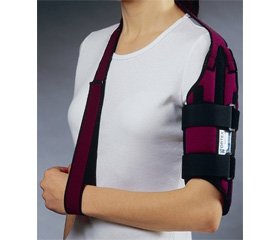Журнал «Травма» Том 16, №2, 2015
Вернуться к номеру
Mathematical modeling of contact stress and the range of motion in the elbow joint in fractures of the distal humerus
Авторы: V. B. Makarov - SI “Specialized medical unit number 6”, Dnepropetrovsk, Ukraine; E. V. Levadnyi - Dnepropetrovsk National University, Ukraine; О. S. Strafun - Department of microsurgery and reconstructive surgery of the upper extremity of SI “Institute of Traumatology and Orthopaedics of Nstional Academy of Medical Sciences of Ukraine”
Рубрики: Травматология и ортопедия
Разделы: Клинические исследования
Версия для печати
distal humerus fracture, range of motion, elbow, contact stress area, the stress-strain state, finite-element mesh.
Introduction and objectives
Treatment of intra-articular fractures of the distal humerus is a complex and versatile problem. Fractures of this localization are relatively rare in the structure of trauma injuries of the musculoskeletal system and make up to 2% of all fractures. However, this injuries are extremely difficult for treatment and achievement of the best possible functional result. There are debates about the indications and contraindications for the conservative treatment, pecularities of surgical approach, and fixation methods in case of surgery.
The purpose of the study was to determine, with the help of mathematical modeling, the relationship between contact stresses, as well as the area of contact in humero-ulnar and humero-radial joints and possible range of motion of the elbow in case of intra-articular fractures of the distal humerus with different values of displacement.
Materials and methods
The authors constructed a necessary geometric model of the elbow joint that meets sufficient requirements for mathematical modeling. In ABAQUS software environment based on constructed geometric model was simulated fracture type 13B2 (AO / ASIF) of distal humerus with different values of displacement of the articular surface of the humerus block. Based on the geometric model the finite-element model was created and numerical experiment performed.
Results and discussion
It was found that an growth in the value of the humerus fragment displacement increases the contact stress in the articular surfaces of humero-radial joint with simultaneous reduction of the contact area. Contact articular surface stresses increase sharply with fragments displacement up to 4-5 mm. It was found the dependence of the angle of flexion and fragment displacement value on the increase on articular contact stresses that shows that the value of fragment displacement up to 2-3 mm in case of 13B2 fractures (AO / ASIF) did not significantly reduce the flexion angle of the elbow despite the increase in contact stresses to 20% -30% compared to the physiological stresses. This fact may reveal the possibility of conservative treatment and further active rehabilitation. Thus intraarticular displacement of fragments up to 2-3 mm can be considered as the maximum displacement, which will not greatly restrict the movements of the elbow.
1. With the help of the developed three-dimensional finite element model of the elbow joint it is possible to carry out the study of stress-strain state either in normal elbow joint or in case of fracture simulation.
2. When considering the contact area of humerus block with the olecranon, we revealed that increase of displacement of bone fragments and an increase in the flexion angle reduces the contact area.
3. It is found that the area of contact between the ulna and humerus in case of bone fragments displacement up to 2 mm is 30% greater than in case of 5 mm displacement and flexion angle of 90º.
4. Due to the decrease of the contact area of the articular surfaces of the ulna and humerus by increasing the displacement of bone fragments and the angle of flexion of the elbow, as well as enlarged contact stresses on the articular surfaces, it can be assumed that the restriction of the angle of flexion will occur due to the violation of congruency of articular surfaces as well as due to pain caused by increased pressure on articular surfaces.
5. It was found that an increase in the displacement of the humerus fragment enlarged the value of contact stress in the articular surfaces of humero-radial joint while reducing the contact area. Contact stresses on articular surfaces increase sharply at 4-5 mm fragment displacement (up 45-50MPa).
6. The dependence of contact stresses growth due to angle of flexion and the displacement of fragments revealed, which shows that the amount of displacement of fragments up to 2-3 mm in the case of fracture type 13B2 (AO / ASIF) did not significantly reduce the angle of elbow flexion, despite the increase of the contact stresses up to 20-30% compared with the physiological stresses. This fact may indirectly indicate a possibility of conservative treatment and an active rehabilitation in follow up period. Thus, intra-articular displacement of fragments up to 2-3 mm can be considered as the maximum displacement that will not appreciably restrict movement of the elbow.

